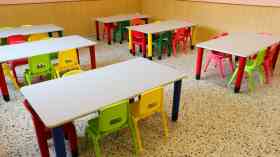A floor with the comfort factor

Sport England guidance notes clearly state: “The most important piece of equipment in a sports hall is the floor.” Yet, it is very often given the least consideration. It is normally installed near to project completion and therefore can become the focus of cost savings.
There are many indoor sports surfaces on the market with a whole host of natural and synthetic products to choose from. Firstly you need to ensure that for a multi purpose sports hall, the manufacturers you shortlist can provide certification for EN14904 compliance.
This European Standard superseded the old British Standard in 2008 and was introduced predominantly to improve user safety. It sets minimum criteria for sports performance, safety and other technical aspects. One aspect of the standard is percentage force reduction. This should be at a minimum of 25 per cent to comply with EN14904.
FLOOR CLASSIFICATION
What’s the importance of force reduction? In summary it helps to reduce the risk of repetitive impact injuries. There are four types of sports floor classification, as defined by the European Standard:
Point Elastic – A synthetic floor that deforms at point of impact, under a user’s foot. A comfortable option that is appropriate when children are primary users.
Area Elastic – Made up of a hard surface such as timber, vinyl or linoleum, because there is no force reducing properties to the surface, it sits on an undercarriage system that provides force reduction.
A Combined Elastic – A sports floor combines the comfort of a point elastic floor with the force reducing qualities of an undercarriage system, hence ‘combined system’ or ‘combo system’. A combined elastic floor offers benefits for a wider range of users.
Finally, rarely seen outside Germany is Mixed Elastic. This is point elastic which sits on a synthetic stiffening component.
Whilst force reduction is a measure that has been around for some time, new research emanating from Europe is highlighting other area areas that should be considered, one of which is comfort. Whist force reduction primarily protects against repetitive injuries, comfort covers the instant sensation felt by users both when exercising and when falling. The science behind sprung floors shows that they start to excel when higher forces are exerted. With force being a combination of weight and velocity, the moment one of those factors decreases, so does the effectiveness of the sprung floor.
With users of lesser weight, or exercising less intensively, there are then benefits from installation of point or combined elastic floors.
COMFORT VALUE
The research in France has focused on comfort, particularly in the education sector. Four years of research by Potiers University, one of the leading Biomechanics departments in France, has led to some interesting conclusions. When an athlete hits the floor, there is obviously a contact area. The larger that contact area, the more comfortable the floor is for the athlete. With point and combined elastic floors, the surface envelopes the part of the body impacting in the same way a mattress on a bed does. This enveloping increases the contact area and therefore increases the comfort value, a measure that certainly the French are looking to employ when comparing floors.
WHAT TO CONSIDER?
There is an ‘intelligent process’ to specifying a sports floor, when we consider a new or replacement indoor sports surface. This includes the need to ask some basic questions prior to project start up, including: What sports will be played on the actual sports floor? What is the anticipated level and frequency of play? Are any national governing bodies for sport contributing financially? Are there any secondary uses? Is there an approved project budget for the installation? What type of surfaces would be ideal for the required sports applications? Traditional or new innovations in flooring?
Other considerations include ongoing maintenance both in terms of costs and time. Will your new surface have to be periodically maintained as well as cleaned daily? How much will this cost over the lifetime of the floor. Is a warranty available? What is the end of life consequence – recycled or land filled? Finally, are there any construction constraints? Gerflor’s advice when reviewing what flooring supplier to use would be to do your research, shop around and if in doubt, revert to the EN standard.
FOR MORE INFORMATION
Web: www.gerflor.co.uk
ABOUT SAPCA
Gerflor is a member of the Sports & Play Construction Association (SAPCA), which represents specialist constructors, manufacturers and suppliers of sports and play surfaces (and related products) and plays an important role in the promotion of high standards for sports and play facilities.
SAPCA offers specifiers and buyers:
• Free advice on what to look for in an indoor floor
• Peace of mind when choosing a supplier that is a SAPCA member (all our members are credit scored annually and have to adhere to strict codes of practice)
• Access to its membership database to source providers of quality installations
• A technical mediation service (in case it is ever needed)
• Access to free seminars and exhibitions
For further details about SAPCA, visit
www.sapca.org.uk, call 024 7641 6316 or e-mail info@sapca.org.uk
Latest News
19/12/2025 - 09:54
The Education Committee has expanded its ongoing inquiry into the early years sector to examine how safeguarding can be strengthened in early years settings.
18/12/2025 - 09:25
The UK will be rejoining the Erasmus programme in 2027, following a package of agreements with the EU.
17/12/2025 - 09:31
Ofqual has fined exam board Pearson more than £2 million in total for serious breaches in three separate cases between 2019 and 2023 which collectively affected tens of thousands of students.
16/12/2025 - 09:19
The average funding rates will increase by 4.3% for under 2s, and by almost 5% for 3-and-4-year-olds.
15/12/2025 - 10:30
Local colleges are set to receive £570 million in government funding to expand training facilities in areas such as construction and engineering.







